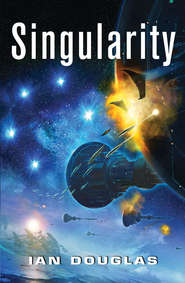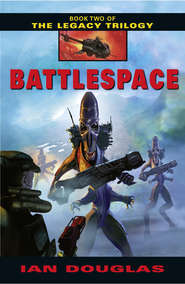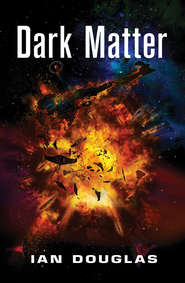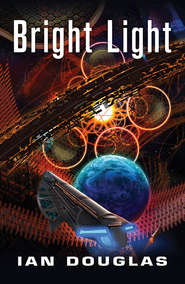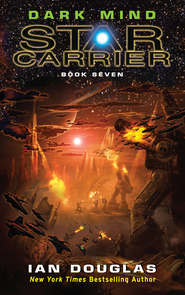По всем вопросам обращайтесь на: info@litportal.ru
(©) 2003-2024.
✖
The Star Carrier Series Books 1-3: Earth Strike, Centre of Gravity, Singularity
Настройки чтения
Размер шрифта
Высота строк
Поля
“I copy, Blue Seven. Blue Five! Blue Four! Get in there and give Blue Seven some backup!”
“Ah, copy, Blue Leader. On our way. …”
The Turusch heavy fighters code-named “Toads” by Confed Military Intelligence were big, ugly brutes thirty meters in length and half that thick. Less maneuverable than their Confederation counterparts, they could accelerate faster, and individually, could take a hell of a lot more punishment in combat. As Gray swung onto an attack vector with the transport, the Toads already released had begun boosting into intercept courses.
“Fox One!” Gray shouted over the net as he released a Krait. “And Fox One … Fox One … Fox One!”
The red-and-black Toad transport was a prime target, easily worth the expenditure of four nuke-tipped Kraits. Confederation fighter pilots steadfastly refused to refer to Fox Tango transports as “carriers.” They insisted that the code name Fox Tango, in fact, was short for “Fat Target” rather than the more prosaic “Fighter Transport.”
Missiles released, Gray snapped out an artificial singularity to port and rolled left, breaking off the run. The enormous transport was throwing up a cloud of defensive fire—sand, gatling KKs, particle beams, and point-defense HELs.
The Toads already released by the transport were falling into echelon formation as they accelerated toward Gray’s fighter. There were five of them, and they were already so close they were beginning to loose missiles at him.
He plunged for atmosphere.
By now he’d bled off most of his velocity, and was dropping toward the planet’s night side at a relatively sedate eight hundred kilometers per second. Using full reverse thrust, he slowed still further as his Starhawk’s crescent shape flattened and elongated somewhat for atmospheric entry, growing aft stabilizers and a refractory keel. He was moving at nearly thirty kilometers per second, eight kps faster than the planet’s escape velocity.
He felt the shudder as his craft sliced through thin atmosphere, and used the aft singularity to slow him further still.
“Alert.” The ship’s computer voice somehow managed to convey the illusion of sharp emotion. “Shielded anti-ship missile closing from one-eight-zero, azimuth plus zero five! Impact in six … five …”
The lost missile, coming in from dead astern. There was no time for maneuvering, and no way to outrun the thing with the bulk of Eta Boötis dead ahead. Gray flipped the fighter end-for-end, searching for the telltale red star of the incoming warhead.
There! Twenty kilometers! Lock … and fire…
The warhead detonated in the same instant that he gave the fire command.
Seconds passed before Gray blinked back to full awareness. Motion-streaked stars alternated with blackness spinning past his field of view. “AI!” he cried out. “Situation!”
There was no immediate response. Possibly, events had momentarily overloaded it. He didn’t need a ship AI to tell him the situation was bad. He was in a tumble, power and drives were out, and he was falling through thin air toward Eta Boötis’s night side at an unknown but fairly high velocity.
Very soon, the Eta Boötean atmosphere would be getting thick enough that the friction would incinerate him.
He was still getting sensor feeds, but life support and other ship’s systems were out. IC was down, com was down, attitude control was down.
The SG-92 Starhawk had a robust and highly intelligent SRS, or self-repair system. Advanced nanotech modules allowed broken or burnt-out systems to literally regrow themselves, dissolving into the ship’s hull matrix, then reassembling. When he checked the details on the dead life-support system, it told him it was 75 percent repaired, and that number jumped to 80 as he watched it. Power and control systems, too, were moments from being back on-line.
He directed the system to give priority to power and flight control; there was enough air in his personal life support to last for quite a while, and the temperature inside the cockpit was not uncomfortable yet.
The operative word being yet. The external temperature was at five hundred Celsius, and rising quickly.
“Blue Omega Flight, this is Blue Seven,” he called, not with any real hope of establishing contact. Communications, according to his IHD, were also down, though there was always the possibility that it was his display or even the ship’s AI that was faulty rather than his lasercom. There was a set list of things to try in the event of catastrophic multiple-system failure, and attempting to reach the other members of the flight was high among the priorities.
As he expected, however, there was no response. He directed the repair systems to lower the priority of the com network in order to focus more of the available power to power and control.
Abruptly, the dizzying alternation of star streaks with planet night halted, the shock of acceleration jolting him hard. He had partial attitude control now, though the main gravs were still out and only a trickle of power was coming through from the zero-point modules. The fighter shuddered as the keel cut thickening atmosphere, shedding more and more velocity.
He searched the sky display for more missiles, but saw none. That didn’t mean they weren’t out there, closing on him. The warhead that had just blasted him into an uncontrolled planetary descent had been shielded and smart, using the sensor-blinding flash of a nuclear detonation to drop to a velocity just faster than the Starhawk without being seen. It had stalked him then, for long seconds, reappearing on his displays only when it began punching through atmosphere, growing hot and leaving a visible contrail.
Turusch anti-fighter missiles, it seemed, were getting smarter and smarter.
But he was deep in the planet’s atmosphere now, and if AFMs were tracking him in, he should be able to spot their ionization contrails. He decided to focus all of his attention on his fighter, and on surviving the next few minutes.
He was close to the dawn terminator, 180 kilometers above the night-black surface of Eta Boötis IV. Daylight was a sharp-edged, red-orange sliver along the curve of the planet, with the intolerably brilliant orange dome of Eta Boötis just beginning to nudge above the horizon. The cloud tops far beneath the Starhawk’s keel were glowing a sullen red, casting long shadows across the deeper cloud decks.
And then the ionization cloud enveloped the Starhawk with the roaring intensity of a blast furnace. The fighter shuddered and bucked as Gray took the manual controls, trying to keep the nose high and spreading the keel to better disperse the heat. He wondered how many Turusch ships might be targeting him right now on his heat signature alone … then decided that since there was nothing he could do about it, there was no sense in worrying. Plenty of debris, from anti-missile sand grains to the shattered hulks of Turusch warships, were falling across the night face of the planet, and his Starhawk was just one more chunk in the debris field.
With manual control restored, he could hold the Starhawk in an entry glide and adjust its attitude, but the gravs were still out, meaning he was falling like a somewhat aerodynamic brick. In any case, primary gravitics were worse than useless in a planetary atmosphere. A 50,000-G singularity would gulp down molecules of air so quickly it would become star-hot in the process, overload, and explode like a tiny supernova. There were weapons—so-called gravitic cannon—that used the effect, and no fighter pilot wanted one of those detonating right off the nose of his ship.
What he did have were his secondary gravitics, drive units built into the structure of his spacecraft that could generate about ten to twelve gravities, and which allowed the Starhawk to hover. Carefully, Gray began feeding power to his secondaries, adding their drag to the already considerable drag of the atmosphere to further slow his descent.
His power tap, fortunately, was feeding him enough power to drive the secondaries at full pull. Without that, he would have been thoroughly and completely screwed. He brought the nose of his ship higher, rotated his acceleration couch into the optimal position, then engaged the secondaries. Without his ICs, his inertial compensators, the shock slammed him down and back against his seat and would have broken bones had the deceleration not scaled up smoothly, if swiftly, from zero-G to ten. He felt the uncomfortable jab of medfeeds pressed against his neck beneath the angle of his jaw, at his back, and in his groin as they monitored and adjusted his blood pressure, keeping him from blacking out. Even so, his vision narrowed alarmingly, as though he were seeing his surroundings through a black tunnel. His IHD, painting images and words against his visual field, winked out momentarily, replaced by white static. For an age, it seemed, he lay there beneath a crushing weight, scarcely able to breathe, blind and deaf as the Starhawk shuddered and thumped and shook around him.
Then, like a drowning man reaching the surface and gulping down fresh air, Gray struggled from the dark and the smothering pressure. The fireball surrounding him dissipated, and he emerged into open air.
And his flight systems were coming back on-line. He had half power now, more than enough for anything short of generating a fifty-K boost. Weapons were on-line, full sensory input, IC, AI, it was all there. Relief burst through him like the golden morning light on the horizon ahead. Voices crackled and called over his audio circuit, the other members of his squadron.
“Blue Ten! Blue Ten! I have Tango fighters inbound at five-zero, Azimuth minus four-one! …”
“Copy, Ten! Breaking right-high!”
“Here’s the merge! I’m on him, Snorky!”
“Fox One! Fox One!” Static flared and crackled, and, with it, a brilliant flash from somewhere above and astern. “Jesus! Did you see that? …”
“Flame one Bravo-Bravo!”
“Blue Omega Leader, this is Blue Seven,” Gray called. “Do you copy?”
“Copy, Seven!” The voice was tight and unemotional—probably Allyn’s AI avatar rather than the squadron CO herself.
“I got toasted a bit and chewed air down to the deck. Systems are back on-line now, at eighty percent. Moving toward the Mike perimeter.”
“We copy that, Blue Seven.” That was the real Commander Allyn’s voice. “Excellent job, Prim. Get in and offer the Marines whatever help they need, channel four-niner-three Zulu. The rest of us will be in there as soon as we can work through.”
Gray felt wildly contrasting emotions, a sharp thrill of pleasure at the atta-boy from his CO, and anger at her use of his detested ready-room handle.
“Rog that,” he replied. He dipped his gravfighter’s nose and accelerated.
He wasn’t quite “down to the deck,” as he’d reported, but close enough. The Starhawk was dropping now past the twenty-kilometer mark. The sky above was still space-dark, the brightest stars—Arcturus, especially—still gleaming and brilliant, but the cloud decks below rose thick and towering, their tops sculpted by high-altitude winds and tinted red and gold by the rising sun. He’d crossed enough of the planet’s face that the local sun was well above the horizon now, casting long, blue-purple shadows and hazy shafts of golden light across the distinctly three-dimensional surface of the cloudscape below.
Gray adjusted his ship’s hull-form again, sculpting it for high-speed aerial flight, absorbing the deep entry keel and extending the wings farther and deeper into their forward-canted configuration. Behind him, a sudden burst of shooting stars marked another cloud of sand or debris entering atmosphere, a barrage of silent flick-flick-flicks of light.
He let his AI target on the Marine beacon, bringing the SG-92’s prow left across the horizon, then dipping down into a plunging dive. He opened his com suite to the Marine frequency and began sending out an approach vector clearance request.
He hadn’t crossed seventy-one AUs and survived a near-miss by a thermonuke to get shot down by the damned jarheads.
MEF HQ






